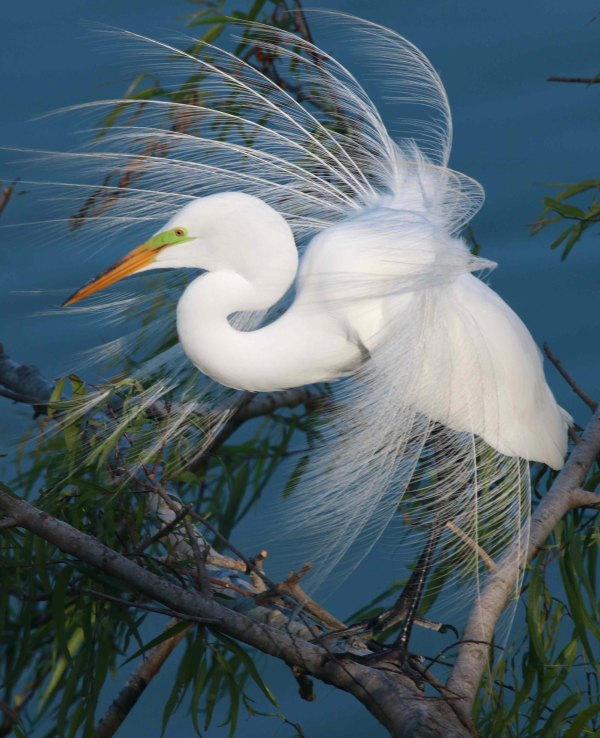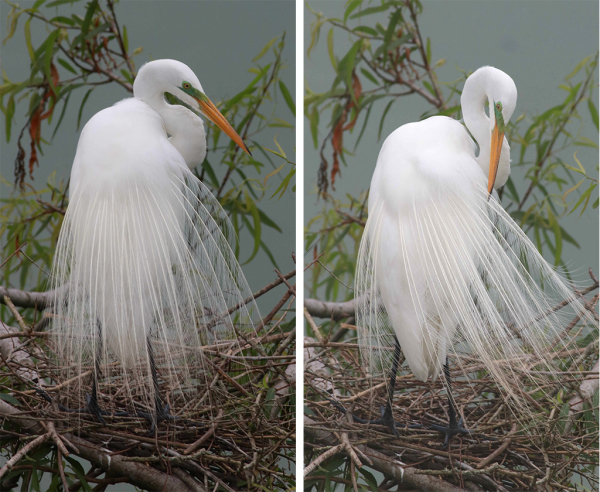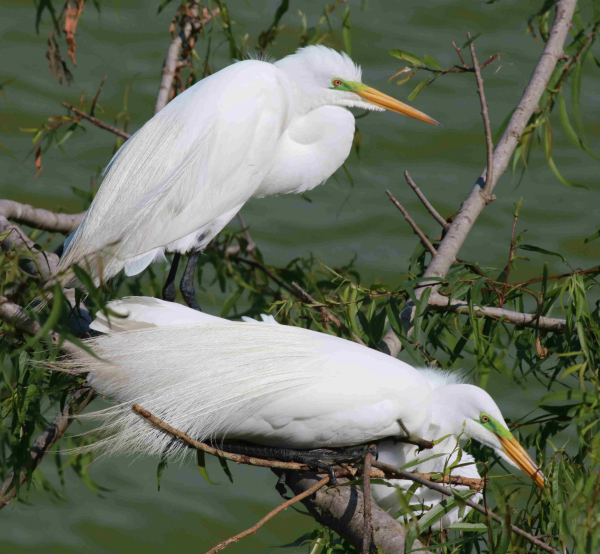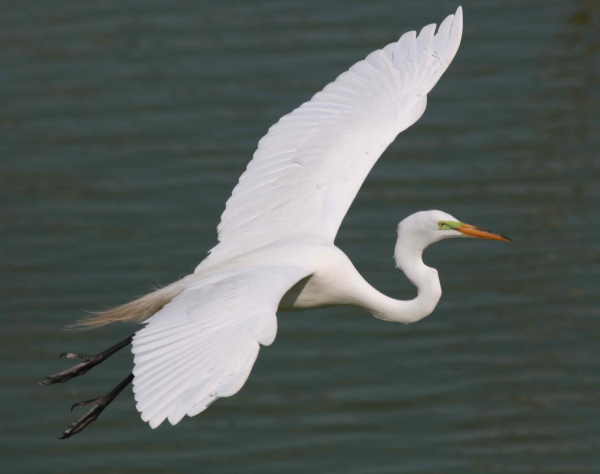As bird photographers, we learn through experience that there is great light, there is poor light, there is adequate light, and there’s terrible light. That’s all forgotten when “dramatic light” beams onto a displaying white bird positioned before a dark background – and you will always know dramatic light when you see it. In some cases it can seem as though a theater spotlight is directed at your subject, and that’s exactly what happened before me in the late hours of the day at the High Island rookery 10 days ago.
Among the remarkable assemblage of nesting wading birds, Great Egrets were active in every aspect of the nesting cycle from displaying and pairing to nest building, egg laying, incubating, and some were even feeding downy nestlings. During my 5 afternoon visits to the Smith Oaks Rookery last week, a spunky male Great Egret took a position in the open top of a willow tree, slightly below the front deck of the elevated Canopy Walkway.

He wasn’t overly aggressive in claiming this precarious location about 8 feet above and to the side of an established pair of Great Egrets still in the nest building phase. The male of that pair was very aggressive, having already established its nesting territory, and it chased the new male off in almost-violent forays. But after the first day, the new male was permitted to display from its selected perch, which would soon become a place to begin depositing stick after stick to build a nest. First though, he would need to attract a female, one who would display with him and accept his nest site as his mate.
That second afternoon, the male was actively displaying from his open perch, providing a beautiful photo subject when he spread the long lacey plumes he grew for this very purpose. As the plumes danced in the breeze and he pumped his neck and called in a low voice, the afternoon light illuminated him beautifully, until the shadows from the majestic oaks behind us overwhelmed the sun rays. Interesting though, after about a half-hour, a beam of sunlight broke through an opening in the leafy canopy with an enhanced quality that illuminated the displaying egret in a unique way. At the same time, the darker background added another element to the dramatic light that I was able to document in a couple photos – until the shadows reclaimed the willows.
The following afternoon, it was especially interesting to find the male had interested a female enough that she joined him on his select branch and joined in short bouts of mutual display. She left and returned a couple times during my photo session, even after the shadows claimed the location where the male had now added 3 or 4 thin sticks as if starting a nest. He spent time arranging and rearranging the sticks that seemed more likely to fall than to form the basis for a much larger nest structure, eventually. But sure enough, the beautiful beam of light slipped through the opening in the oak leaves to illuminate the future nest site and the egret that may have selected this location for just that reason – or was it just by serendipitous luck that this light beam landed exactly on that location?

Issue Issues, Lighting Issues
As noted last week, I decided to spend my weekend in the High Island area while I produced this issue of The Birding Wire, especially to have the rookery close at hand so I could take advantage of the bird photography during prime afternoon photo periods when sunshine prevailed from behind my back as I perched on the far deck of the Canopy Walkway. It’s hard to convey how exciting it is to observe and photograph the behaviors and flights of Great Egrets, Roseate Spoonbills, Tricolored Herons, Snowy Egrets, and more in the ever-moving swirl around the rookery.
With the opportunity to photograph 5 of the 6 days I was at High Isle last week, I was blessed with excellent light, good light, and perfect light, in addition to dramatic light; but on the last day, dull cloudy light dominated. My timing of photographing during the late afternoon provided all the good and great light opportunities, but as I often share, I prefer to stay home rather than photograph in the dull inadequate overcast lighting. So Tuesday, when I most needed to concentrate on finishing the last issue, I stayed home when it was cloudy and sprinkling.

The following day, it was overcast again when I intended to head to Houston, but a vehicle emergency forced me to spend another day at High Island. I was a bit disappointed to be delayed, but knew there was no alternative, so back to the rookery and songbird hotspot I went until my vehicle was repaired hours later. Because it was cloudy with pretty low light, I knew the direction of the light was less of a factor, so I thought I’d do my best and see how some photos turned out during midday and again during mid-afternoon.
For the most part, the flight photos were semi-terrible in the clouded light, but photos of perched or standing birds were better at times. When I reviewed the images, a couple photos of the displaying male egret stood out, and although the original image had dull lighting, I merely tried “brightening” the photo using my photo editing software. It worked very well for that particular photo and a sister photo, which are included in this article to illustrate “before and after” brightening the second photo.

Light Tech
With a variety of lighting conditions during different afternoons, when the sky was clear I used my usual f-8 aperture unless the light was waning a bit toward the end of the afternoon, but even then I just switched to an f-7 aperture to get a little faster shutter speed. Using the Av (Aperture Priority) setting, the camera provided fast shutter speeds ranging from 1/1000 to 1/1250 in the first 2 “dramatic light” photos that illustrate this article, and 1/3200 in the photo of the pair at the nest in “perfect light.” I was surprised to see the “dull” photos were taken at 1/2500 of a second considering they were taken during midday under cloudy conditions.
Although I actually didn’t intend to follow the progress of the Great Egret’s efforts to establish a nesting territory, attract a mate, and begin nest building, it was especially interesting to follow the process that transpired much quicker than I would have imagined. I think the resulting photos document the process fairly well, but more important for you, they illustrate how the different lighting conditions in resulting photographs provide some good examples of what to watch for while photographing birds in varied light conditions.

The photos featured in this article are another example of the kinds of opportunities and insights you can enjoy when spending a little extra time at a photo hotspot like High Island’s Smith Oaks Rookery. Whenever possible, try to search out a prime location near you to spend some extended time photographing – maybe even this spring.
Article and photographs by Paul Konrad
Share your bird photos and birding experiences at editorstbw2@gmail.com